article In conversation with
Suzi Morris
In conversation with
Suzi Morris
Suzi Morris
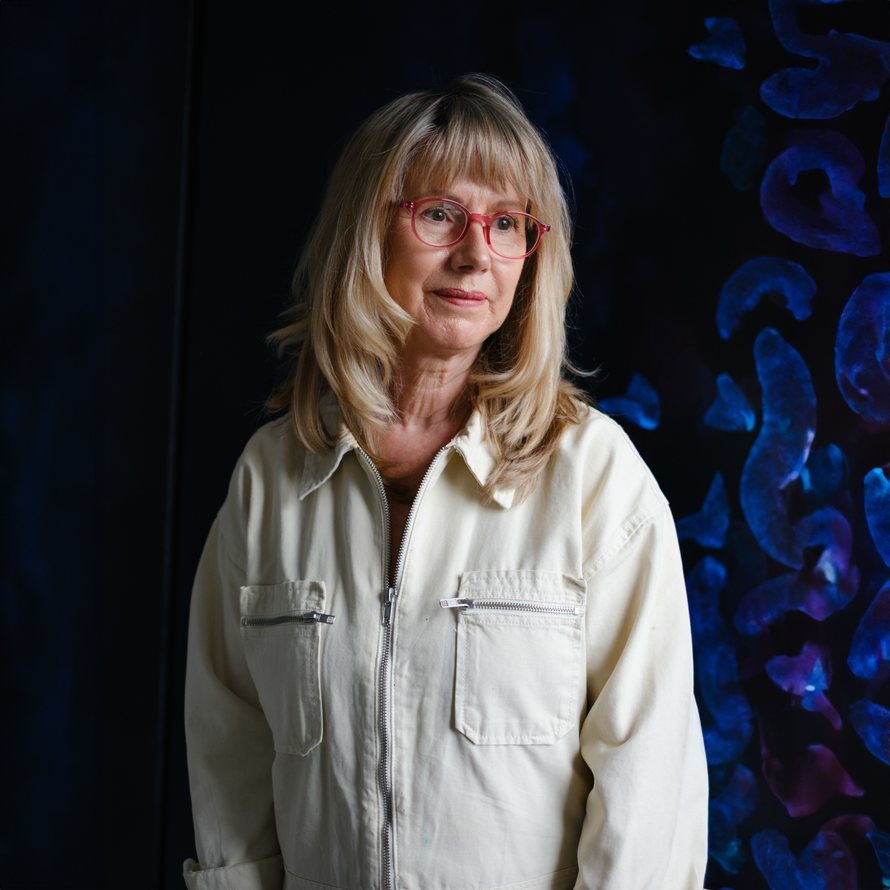
In conversation with Suzi Morris about the
microscopic lens of abstraction and the
magical build-ability of oil paints.
microscopic lens of abstraction and the
magical build-ability of oil paints.
In conversation with Suzi Morris about the
microscopic lens of abstraction and the
magical build-ability of oil paints.
Suzi Morrisis a Scottish painter living and working in London. Using oil paint, her work explores the relationship between art, virology and the concept of the sublime. Through an experimental process of composition and erasure Suzi’s paintings evolve through veils of translucent colour that combine aesthetic, historic and scientific concerns.
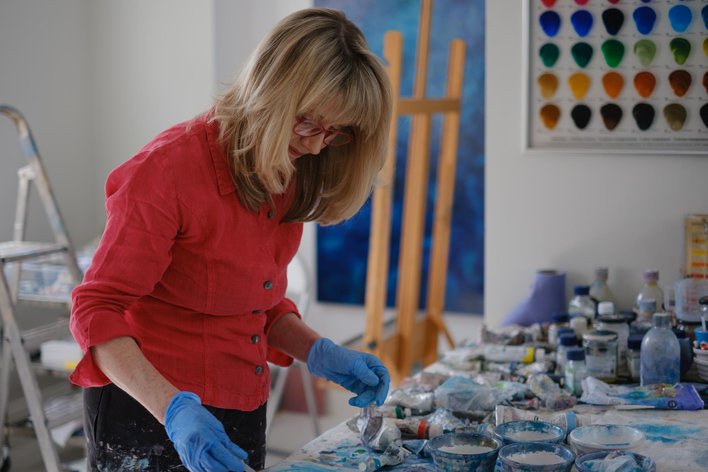
Artiq You are interested in science, the sublime and virology within your practice. Could you speak a bit more about how these themes influence your work?
Suzi The sense of wonder at the ways in which AI is revolutionising medico-scientific discoveries is fuel for my subconscious in making work. An interest in the nature of our bodies and evolution has culminated in my body becoming a site of inquiry. I find the language of science seeps into my paintings. An affiliation with Imperial College, London aids in my understanding of how synthetic biologists are harnessing the power of nature, using viruses to solve problems in medicine, agriculture, ageing and disease. Then there are the bioethical issues of redesigning organisms for useful purposes by engineering them to have new curative abilities. All this insight not only triggers a sense of awe, but raises awareness of self and the potential for terrifying and harmful outcomes were this science to fall into nefarious hands. This realisation draws me to Edmund Burke’s notion of the sublime. While artists of the Romantic era were inspired by the overwhelming power of the natural world, I’m reimagining the sublime today through the microscopic lens of abstraction.
Artiq Your work has a timeless feel, bringing together a variety of different brushstrokes, marks and gestures together on the canvas. Which artistic movements most inspire this way of working? Why?
Suzi Orphism is the movement which most inspires my way of working since it was about consciousness, expressing mental inner experience without having to describe a physical reality. This period marked the beginning of painting that was independent of any reference to the visible objective world when artists such as Odilon Redon and František Kupka were responding to the scientific discoveries of their time. Art is often about our own sense of mortality and creating a language of gestures to evoke meaning. The diversity of marks that I’m making can evolve from feeling shy or confident, fearful or hopeful, or they may not even be explainable until after I’ve completed the work. Drawing to an extent on my subconscious in to direct the viewer away from the material world and offer an opportunity to question and draw upon their own conscious reading of the work.
Suzi The sense of wonder at the ways in which AI is revolutionising medico-scientific discoveries is fuel for my subconscious in making work. An interest in the nature of our bodies and evolution has culminated in my body becoming a site of inquiry. I find the language of science seeps into my paintings. An affiliation with Imperial College, London aids in my understanding of how synthetic biologists are harnessing the power of nature, using viruses to solve problems in medicine, agriculture, ageing and disease. Then there are the bioethical issues of redesigning organisms for useful purposes by engineering them to have new curative abilities. All this insight not only triggers a sense of awe, but raises awareness of self and the potential for terrifying and harmful outcomes were this science to fall into nefarious hands. This realisation draws me to Edmund Burke’s notion of the sublime. While artists of the Romantic era were inspired by the overwhelming power of the natural world, I’m reimagining the sublime today through the microscopic lens of abstraction.
Artiq Your work has a timeless feel, bringing together a variety of different brushstrokes, marks and gestures together on the canvas. Which artistic movements most inspire this way of working? Why?
Suzi Orphism is the movement which most inspires my way of working since it was about consciousness, expressing mental inner experience without having to describe a physical reality. This period marked the beginning of painting that was independent of any reference to the visible objective world when artists such as Odilon Redon and František Kupka were responding to the scientific discoveries of their time. Art is often about our own sense of mortality and creating a language of gestures to evoke meaning. The diversity of marks that I’m making can evolve from feeling shy or confident, fearful or hopeful, or they may not even be explainable until after I’ve completed the work. Drawing to an extent on my subconscious in to direct the viewer away from the material world and offer an opportunity to question and draw upon their own conscious reading of the work.
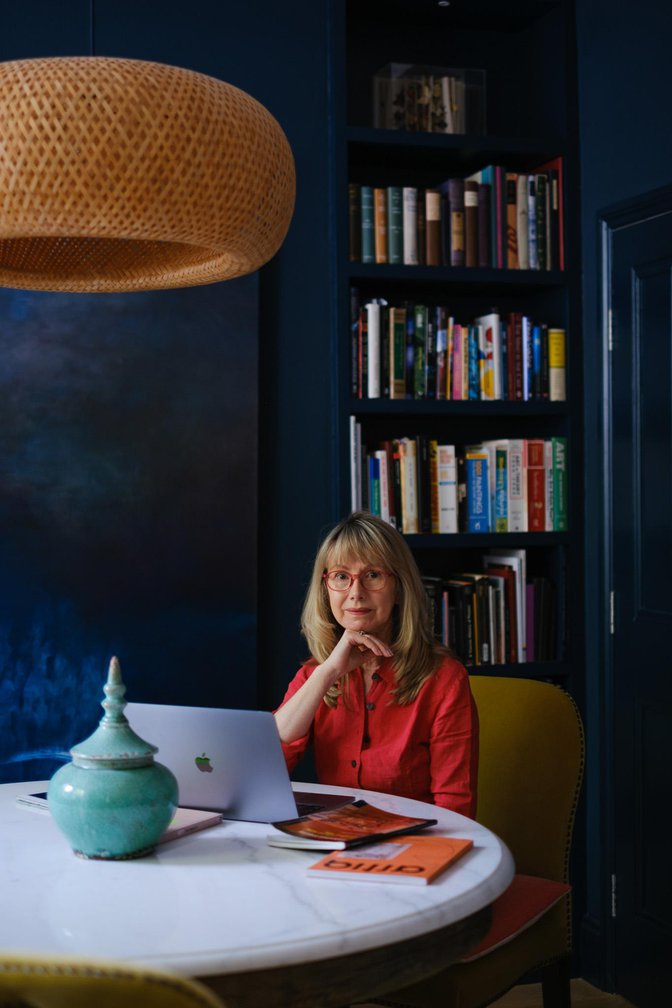
Artiq You work frequently with oil paints in your practice, often adding and removing layers to create the final piece. Could you elaborate on this process, and how you build up the images on your canvas?
Suzi I find painting in oils quite magical in the ways that, through building up the surface with layers of varying opacities, a co-emergent process occurs as paint and body enter into a dialogue. Often, it’s as much about negation of parts of the image as it is about addition of material. Revealing earlier parts of the work exposes the history of the process, while the materiality of oil paint and use of layering as a process acts as a vehicle for meaning. Over time, paintings become cerebral images of my thoughts on the body where I arrive at a place that I have imagined, but it is a place that I could not have known until it was painted. It’s a slow practice because I have to factor in drying times between layers. With the addition of my own mediums and experimenting, oil paint has so much potential for transformation, destruction and resurrection. It’s a sensory discovery through the material itself. I’m incredibly fortunate to be an ambassador for German companies da Vinci and Schmincke. This affiliation keeps me open to new ideas using the latest materials and up to date regarding lightfastness of pigments and the making of mediums.
Artiq Can you tell us about the significance of ‘line’ throughout your work?
Suzi The lines function as a metaphor for the human in the landscape. In science, biomarkers are measurable markers which serve multiple purposes, one being as a diagnostic means to measure human susceptibilities. They are the ‘stories’ of our health: a measure that indicates the presence of life. In my work the lines also act as the formal decision ‘lines’ that alter our perception in defining the space. Their presence opens up a dialogue between stillness and unrest. They also pay homage to the modernist heyday of the colour field painters such as Helen Frankenthaler and Barnett Newman. Concerning origin and meaning, my use of line is actively connected to the world which I inhabit: a world of medical intervention, genetic engineering, biomarkers and new AI technologies that will change what it means to be human in the future.
Suzi I find painting in oils quite magical in the ways that, through building up the surface with layers of varying opacities, a co-emergent process occurs as paint and body enter into a dialogue. Often, it’s as much about negation of parts of the image as it is about addition of material. Revealing earlier parts of the work exposes the history of the process, while the materiality of oil paint and use of layering as a process acts as a vehicle for meaning. Over time, paintings become cerebral images of my thoughts on the body where I arrive at a place that I have imagined, but it is a place that I could not have known until it was painted. It’s a slow practice because I have to factor in drying times between layers. With the addition of my own mediums and experimenting, oil paint has so much potential for transformation, destruction and resurrection. It’s a sensory discovery through the material itself. I’m incredibly fortunate to be an ambassador for German companies da Vinci and Schmincke. This affiliation keeps me open to new ideas using the latest materials and up to date regarding lightfastness of pigments and the making of mediums.
Artiq Can you tell us about the significance of ‘line’ throughout your work?
Suzi The lines function as a metaphor for the human in the landscape. In science, biomarkers are measurable markers which serve multiple purposes, one being as a diagnostic means to measure human susceptibilities. They are the ‘stories’ of our health: a measure that indicates the presence of life. In my work the lines also act as the formal decision ‘lines’ that alter our perception in defining the space. Their presence opens up a dialogue between stillness and unrest. They also pay homage to the modernist heyday of the colour field painters such as Helen Frankenthaler and Barnett Newman. Concerning origin and meaning, my use of line is actively connected to the world which I inhabit: a world of medical intervention, genetic engineering, biomarkers and new AI technologies that will change what it means to be human in the future.
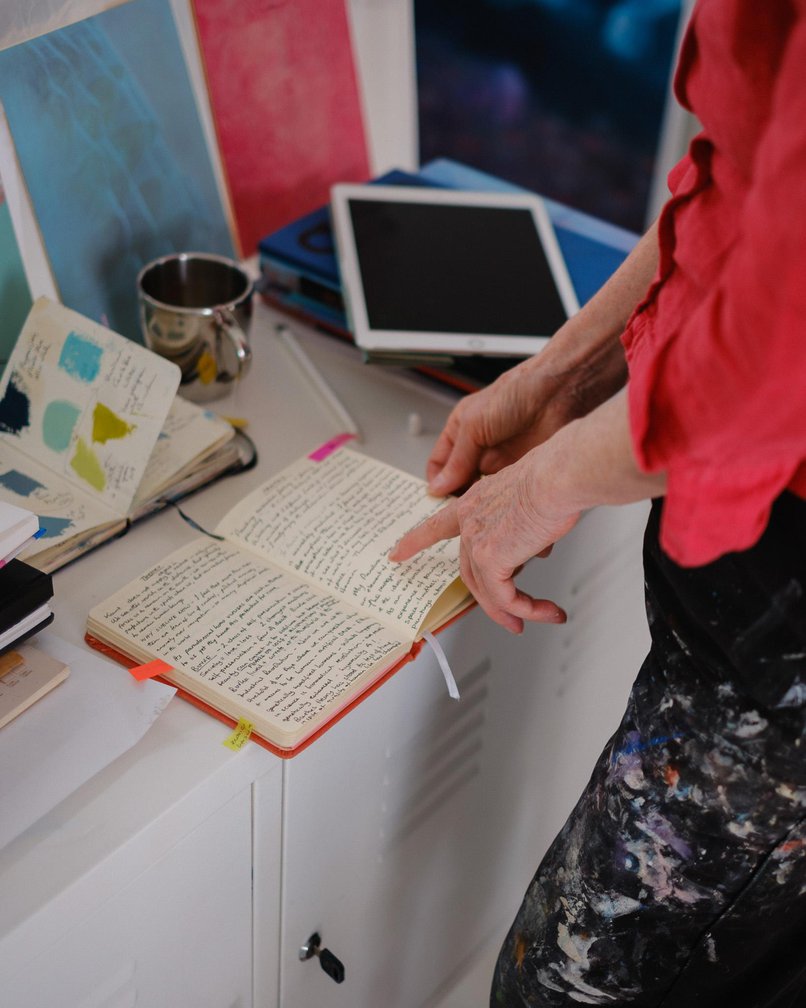
Artiq You’ve previously discussed the connection with your body as a lived embodiment of experience as a muse. Can you elaborate more about this as an inspiration?
Suzi My excursions into the otherwise ‘unseen’ of the human body, result from a deep awareness of self and having heightened sensitivities which are reflected in the work. Diagnosed with PTSD a few years ago, my sensory processing is now so attuned to what’s happening in my body that it has become my muse. The field of epigenetics now recognizes that human levels of sensory awareness are not purely genetic, but determined by our lived experience and environment. Having a rich and complex inner life has turned out to be a positive resource for my painting. The works often deviate in unexpected ways and wax into an extension of my innermost core. Only then can I see the theory, inspiration and historical references that have come together to inspire the work.
Artiq Some of your work contains visual similarities in how it represents medical subjects, such as your representation of the genetic with ‘Genetic Spaghetti’, ‘The Hidden Dance of the Cell’, and ‘Gene Flow’. Can you describe how you began to create your own visual language in relation to these themes?
Suzi I come from a line of medics and scientists, while my mother was an artist, so from a very young age I developed a fascination for the otherwise ‘unseen’ world beneath the microscope. Around the time that my mother died when I was a child, thus began a multitude of health issues which continued into adulthood. With the onset of new technologies, I’ve now seen multiple scans of most parts of my own body, and come to understand that my painterly language is evolving out of the physiology of the body. Lived experience and painting have become inextricably intertwined. It’s as if painting from the body and listening to the language of science has become a methodology. My subconscious transforms observations into cerebral images. My relationship with Imperial College since my PhD research continues to open up the much wider global concerns around human health, and how our bodies will benefit from artificial intelligence in the future. None of us want to age and we all desire joy and well-being so it’s all very inspiring.
Suzi My excursions into the otherwise ‘unseen’ of the human body, result from a deep awareness of self and having heightened sensitivities which are reflected in the work. Diagnosed with PTSD a few years ago, my sensory processing is now so attuned to what’s happening in my body that it has become my muse. The field of epigenetics now recognizes that human levels of sensory awareness are not purely genetic, but determined by our lived experience and environment. Having a rich and complex inner life has turned out to be a positive resource for my painting. The works often deviate in unexpected ways and wax into an extension of my innermost core. Only then can I see the theory, inspiration and historical references that have come together to inspire the work.
Artiq Some of your work contains visual similarities in how it represents medical subjects, such as your representation of the genetic with ‘Genetic Spaghetti’, ‘The Hidden Dance of the Cell’, and ‘Gene Flow’. Can you describe how you began to create your own visual language in relation to these themes?
Suzi I come from a line of medics and scientists, while my mother was an artist, so from a very young age I developed a fascination for the otherwise ‘unseen’ world beneath the microscope. Around the time that my mother died when I was a child, thus began a multitude of health issues which continued into adulthood. With the onset of new technologies, I’ve now seen multiple scans of most parts of my own body, and come to understand that my painterly language is evolving out of the physiology of the body. Lived experience and painting have become inextricably intertwined. It’s as if painting from the body and listening to the language of science has become a methodology. My subconscious transforms observations into cerebral images. My relationship with Imperial College since my PhD research continues to open up the much wider global concerns around human health, and how our bodies will benefit from artificial intelligence in the future. None of us want to age and we all desire joy and well-being so it’s all very inspiring.
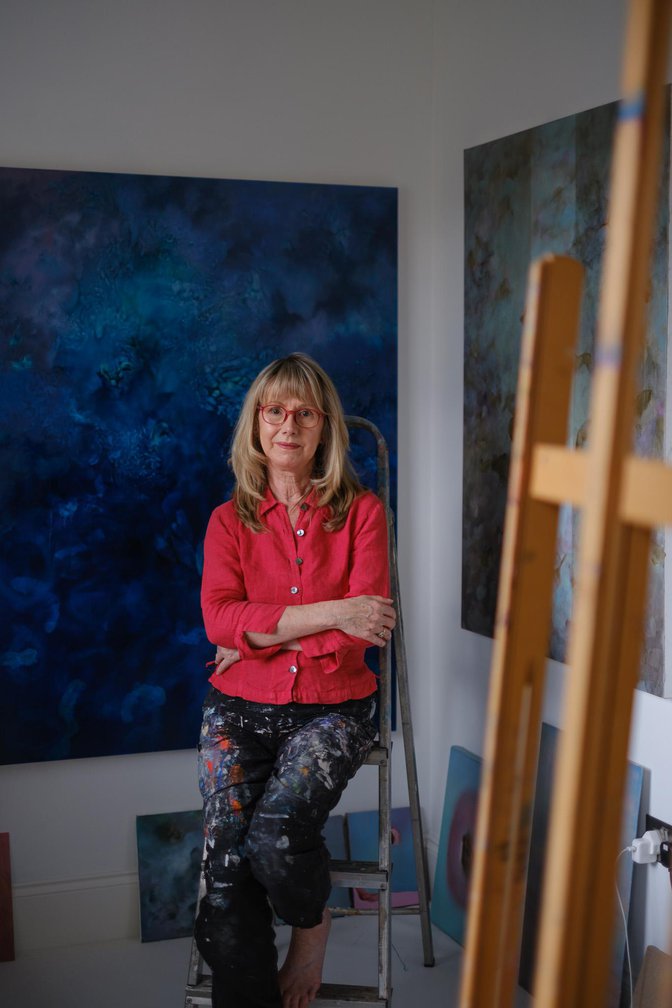
Artiq You’ve worked on a range of materials such as steel, aluminium, and canvas. How do the materiality of these factor into your practice?
Suzi Starting any dialogue between painting and the surface begins with questions about substrate. I enjoy exploring how paint ‘reads’ on different surfaces such as canvas, wood, aluminium or steel. Choice of ground is key to the thought processes that preceded them. The genesis of each painting is often more about subtracting and editing thoughts and ideas rather than the immediate projection of a concept. By way of an example, I chose to work on steel panels for my solo show in Scotland where I grew up. My father had recently passed away and having dedicated his PhD research to the Scottish Steel Industry, I commissioned five bespoke steel panels from the area where he had worked as a tribute to his life’s work. Handling raw steel was quite challenging and it’s extremely heavy but nonetheless I love the slippery surface and how oil pigment responds to that. The marks and gestures are so different on canvas.
Artiq Are there any upcoming projects that you would like to share with us?
Suzi I’m very excited to have just been accepted by a publisher to create a publication of my paintings and a selection of poems relating to them, by Vancouver based performance artist and author, Celeste Snowber PhD. About a year ago, Celeste began responding to my paintings with poetry. One thing led to another and now we are looking at spaces in which to have a joint exhibition of poetry, painting and performance to accompany the launch of the book.
I’m also thrilled to be working with Artiq on a commission. This will be my biggest commission to date so I’m incredibly grateful to be given such a wonderful opportunity.
Suzi Starting any dialogue between painting and the surface begins with questions about substrate. I enjoy exploring how paint ‘reads’ on different surfaces such as canvas, wood, aluminium or steel. Choice of ground is key to the thought processes that preceded them. The genesis of each painting is often more about subtracting and editing thoughts and ideas rather than the immediate projection of a concept. By way of an example, I chose to work on steel panels for my solo show in Scotland where I grew up. My father had recently passed away and having dedicated his PhD research to the Scottish Steel Industry, I commissioned five bespoke steel panels from the area where he had worked as a tribute to his life’s work. Handling raw steel was quite challenging and it’s extremely heavy but nonetheless I love the slippery surface and how oil pigment responds to that. The marks and gestures are so different on canvas.
Artiq Are there any upcoming projects that you would like to share with us?
Suzi I’m very excited to have just been accepted by a publisher to create a publication of my paintings and a selection of poems relating to them, by Vancouver based performance artist and author, Celeste Snowber PhD. About a year ago, Celeste began responding to my paintings with poetry. One thing led to another and now we are looking at spaces in which to have a joint exhibition of poetry, painting and performance to accompany the launch of the book.
I’m also thrilled to be working with Artiq on a commission. This will be my biggest commission to date so I’m incredibly grateful to be given such a wonderful opportunity.